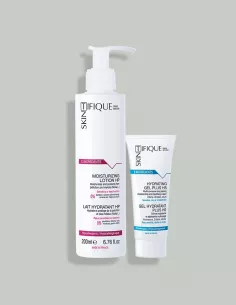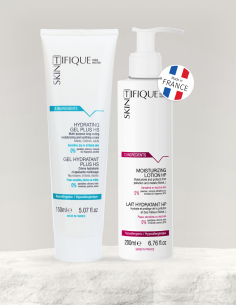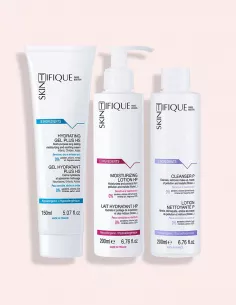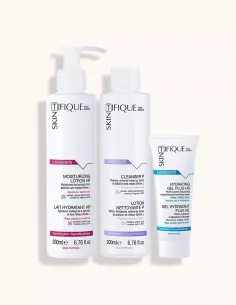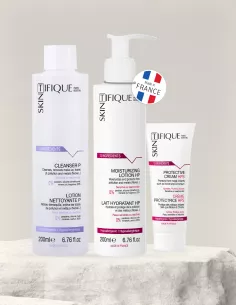TIP #1
IDENTIFY THE TYPE OF ECZEMA
Eczema comes in many types, each with its own symptoms and causes.
Even though some symptoms, like itching, irritation, and red patches, are consistent across the common types of eczema (atopic eczema, contact eczema, dyshidrotic eczema, seborrheic eczema), each condition requires different products and routines to manage and prevent flare ups.
So, the first step in treating eczema is identifying it!
THE FOUR MAIN
TYPES OF ECZEMA
Recognize your eczema based on the symptoms :
ATOPIC ECZEMA
Of genetic origin, skin is said to be atopic when it does not play its role as a natural barrier. Atopic skin also has more difficulty retaining water than normal skin.
People with atopic eczema or atopic dermatitis thus develop a strong sensitivity to all the allergens in the environment and experience red patches, itching, and scaling during flare ups.
Contact eczema
If you're experiencing contact eczema, your skin is simply reacting to a specific allergen in your environment. As soon as your skin comes into contact with this allergen, you'll experience a hyper-localized reaction of red patches accompanied by small, fluid-filled blisters.
Seborrheic eczema
Seborrheic eczema, or seborrheic dermatitis, is characterized by red patches and whitish scales, most commonly found on the face, scalp, or other areas rich in sebum.
dyshidrotic eczema
Dyshidrotic eczema, which affects the hands in 80% of cases, can cause burning and itching sensations and can be caused by a number of factors, including fungal infections, excessive sweating, atopic skin, or allergens in the environment.
THE FOUR MAIN
TYPES OF ECZEMA
Recognize your eczema based on the symptoms :
Atopic Eczema
Of genetic origin, skin is said to be atopic when it does not play its role as a natural barrier. Atopic skin also has more difficulty retaining water than normal skin.
People with atopic eczema or atopic dermatitis thus develop a strong sensitivity to all the allergens in the environment and experience red patches, itching, and scaling during flare ups.
Contact eczema
If you're experiencing contact eczema, your skin is simply reacting to a specific allergen in your environment. As soon as your skin comes into contact with this allergen, you'll experience a hyper-localized reaction of red patches accompanied by small, fluid-filled blisters.
Seborrheic eczema
Seborrheic eczema, or seborrheic dermatitis, is characterized by red patches and whitish scales, most commonly found on the face, scalp, or other areas rich in sebum.
dyshidrotic eczema
Dyshidrotic eczema, which affects the hands in 80% of cases, can cause burning and itching sensations and can be caused by a number of factors, including fungal infections, excessive sweating, atopic skin, or allergens in the environment.
THE FOUR MAIN
TYPES OF ECZEMA
Recognize your eczema based on the symptoms :
Atopic Eczema
Of genetic origin, skin is said to be atopic when it does not play its role as a natural barrier. Atopic skin also has more difficulty retaining water than normal skin.
People with atopic eczema or atopic dermatitis thus develop a strong sensitivity to all the allergens in the environment and experience red patches, itching, and scaling during flare ups.
contact eczema
If you're experiencing contact eczema, your skin is simply reacting to a specific allergen in your environment. As soon as your skin comes into contact with this allergen, you'll experience a hyper-localized reaction of red patches accompanied by small, fluid-filled blisters.
Seborrheic eczema
Seborrheic eczema, or seborrheic dermatitis, is characterized by red patches and whitish scales, most commonly found on the face, scalp, or other areas rich in sebum..
dyshidrotic eczema
Dyshidrotic eczema, which affects the hands in 80% of cases, can cause burning and itching sensations and can be caused by a number of factors, including fungal infections, excessive sweating, atopic skin, or allergens in the environment.
TIP #2
Moisturize your skin daily
Keeping your skin’s moisture intact is one of the most important things you can do to help control your eczema.
Moisturizers helps protect the outermost layer of skin known as the stratum corneum or skin barrier. People living with eczema have a damaged skin barrier, which makes their skin more sensitive to irritants, allergens, bacteria and other invaders. A damaged skin barrier also make it harder for the skin to retain water, leading to chronic dry, itchy skin, which can cause eczema to flare or get worse.
National Eczema Association
Well moisturized skin
means less flare ups!
While there is no miracle cure for most types of eczema, taking care to ensure that your skin is well moisturized helps limit the risk and intensity of flare ups. Plus, you'll be keeping your skin soft too!
BETWEEN FLARE-UPS
Good skin hydration reduces the frequency and intensity of flare ups.
Even when the skin seems in good shape, it is important to continue to provide daily moisturizing and care.
This is particularly true in winter and when the weather is cold, as low temperatures hurt and dry the skin. It is also true in summer when the sun also affects the skin!
DURING FLARE-UPS
When used as companion care, sometimes in combination with treatments prescribed by a healthcare professional, efficient skin moisturizing reduces the intensity of the flare ups. During flare ups, moisturizer can soothe the skin, reduce pain, restore the skin barrier, soften the skin, restore elasticity, and limit the side effects of dermo-coticoids and other drugs common in eczema treatment.
Keeping your skin’s moisture intact is one of the most important things you can do to help control your eczema.
Moisturizers helps protect the outermost layer of skin known as the stratum corneum or skin barrier. People living with eczema have a damaged skin barrier, which makes their skin more sensitive to irritants, allergens, bacteria and other invaders. A damaged skin barrier also make it harder for the skin to retain water, leading to chronic dry, itchy skin, which can cause eczema to flare or get worse.
National Eczema Association
well moisturized skin
means less flare ups!
While there is no miracle cure for most types of eczema, taking care to ensure that your skin is well moisturized helps limit the risk and intensity of flare ups. Plus, you'll be keeping your skin soft too!
BETWEEN FLARE-UPS
Good skin hydration reduces the frequency and intensity of flare ups.
Even when the skin seems in good shape, it is important to continue to provide daily moisturizing and care.
This is particularly true in winter and when the weather is cold, as low temperatures hurt and dry the skin. It is also true in summer when the sun also affects the skin!
DURING FLARE-UPS
When used as companion care, sometimes in combination with treatments prescribed by a healthcare professional, efficient skin moisturizing reduces the intensity of the flare ups. During flare ups, moisturizer can soothe the skin, reduce pain, restore the skin barrier, soften the skin, restore elasticity, and limit the side effects of dermo-coticoids and other drugs common in eczema treatment.
TIP #3
THREE STEPS TO COMBATTING THE 4 COMMON TYPES OF ECZEMA
Atopic
Eczema
Metal
allergy
seborrheic
dermatitis
dyshidrosis
atopic
eczema
atopic
eczema
STEP 1
MOISTURIZE
Keep your skin moisturized to strengthen its barrier function.
STEP 2
PROTECT
Protect your skin from dryness and allergens that trigger flare ups.
STEP 3
SOOTHE
Soothe the sensations of itching and tightness.
STEP 1
MOISTURIZE
Keep your skin moisturized to strengthen its barrier function.
STEP 2
PROTECT
Protect your skin from dryness and allergens that trigger flare ups.
NEED #3
SOOTHE
Soothe the sensations of itching and tightness.
seborrheic
dermatitis
seborrheic
dermatitis
STEP 1
CLEAN
Gently cleanse excess sebum from the skin.
STEP 2
CALM
Calm itching and soothe the skin
STEP 3
STRENGTHEN
Improve the skin's barrier function
STEP 1
CLEAN
Gently cleanse excess sebum from the skin.
STEP 2
TO CALM
Calm itching and soothe the skin
STEP 3
STRENGTHEN
Improve the skin's barrier function
Dyshidrosis
STEP 1
CLEAN
Cleanse your skin, especially after contact with an allergen or intense sweating
STEP 2
PROTECT
Protect your skin from the main allergens that trigger flare-ups
STEP 3
MOISTURIZE
Hydrate your skin after cleansing
STEP 1
CLEAN
Cleanse your skin, especially after contact with an allergen or intense sweating
STEP 2
PROTECT
Protect your skin from the main allergens that trigger flare-ups
STEP 3
MOISTURIZE
Hydrate your skin after cleansing
CONTACT Eczema OR
METAL ALLERGY
CONTACT ECZEMA OR
METAL ALLERGY
STEP 1
PROTECT
Protect your skin from contact with allergenic metals
STEP 2
STRENGTHENS
Improve the skin's barrier function through hydration
STEP 3
CLEAN
Cleanse your skin after contact with an allergenic metal
STEP 1
PROTECT
Protect your skin from contact with allergenic metals
STEP 2
STRENGTHENS
Improve the skin's barrier function through hydration
STEP 3
CLEAN
Cleanse your skin after contact with an allergenic metal
Eczema
Available bundles
$48.00
$56.00
$67.00
$62.00
$52.00
LIBERATING
skincare
LIBERATING
skincare
WHY CHOOSE
SKINTIFIQUE
Skintifique helps people with sensitive, intolerant and allergic skin free themselves from their constraints with natural formulations and innovative and patented technologies
Made in
FRANCE
Our products are designed and made in France, with locally sourced ingredients and packaging
Natural
& SAFE
Our formulations are based on natural, proven ingredients
Technologies
& PATENTS
Our experts have developed 2 technologies protected by international patents
WHY CHOOSE
SKINTIFIQUE
Skintifique helps people with sensitive, intolerant and allergic skin free themselves from their constraints with natural formulations and innovative and patented technologies
Made in
FRANCE
Our products are designed and made in France, with locally sourced ingredients and packaging
Natural
& SAFE
Our formulations are based on natural, proven ingredients
Technologies
& PATENTS
Our experts have developed 2 technologies protected by international patents
Skintifique
It's also on amazon!
Do you have an Amazon Prime account?
Find us on Amazon.com or Amazon.co.uk
Skintifique
It's also on amazon!
Do you have an Amazon Prime account?
Find us on Amazon.com or Amazon.co.uk

